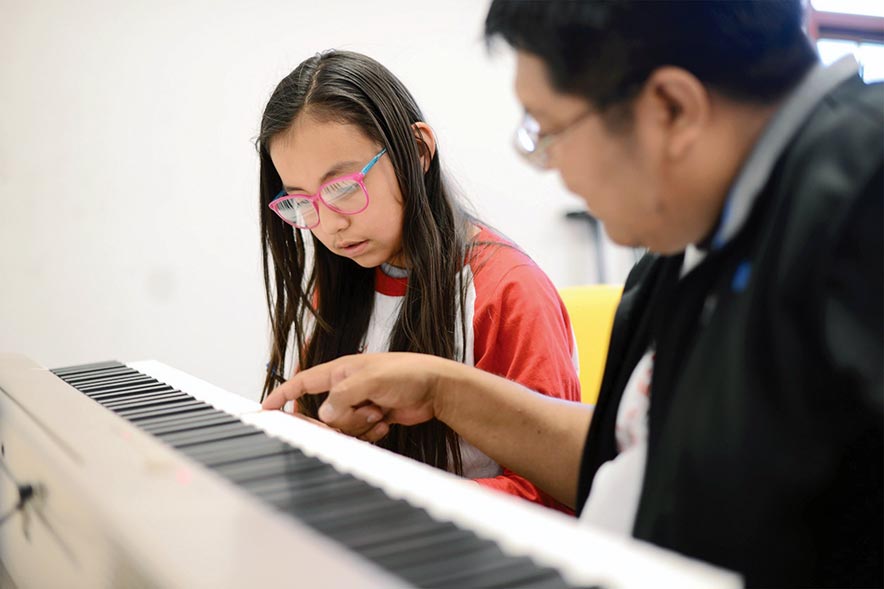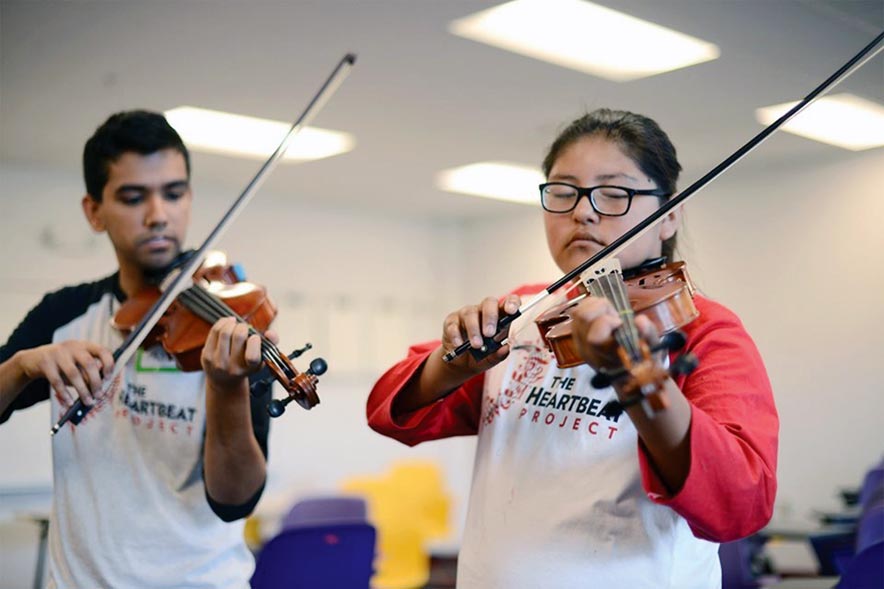
A dream come true: Crownpoint nonprofit awarded half-a-million-dollar grant

Courtesy Photo | HeartBeat Project
Navajo students in grades K to 12 can learn to play musical instruments including the piano during the 2019 HeartBeat Project Academy in Crownpoint. After two years, the project will be having their in-person academy in summer 2022.
By Pauly Denetclaw
Special to the Times
AUSTIN, Texas
The effects of the pandemic have also fallen on the Heartbeat Music Project, a nonprofit musical program that runs during the summer and fall for Navajo youth.
This program was created to offer music lessons during the summer and fall breaks at no cost to Navajo students from the Eastern and Northern agencies.
Due to the ongoing pandemic that has disproportionately impacted the Navajo Nation for the past two summers, the program had to cancel in-person programs and opted for online lessons.
“Our students are tired of Zooming all the time, but that’s the only way right now,” said Sharon Nelson, the executive director for the project.
But 2022 started on a high note when the project was awarded the Accelerator Award from the Lewis Prize for Music that gives four music programs a $500,000 grant. Programs from across the country apply for the grant.
“We just feel so fortunate,” Nelson said. “We have a great team, a small team, that has worked so hard to grow this program.”
Beginning with 5 students
The program was founded in 2016 by violinist Ariel Horowitz, a graduate of the Yale School of Music, and started with just five students who learned how to play the violin.
Since then, the program has grown to serve 70 Navajo students from as far as Farmington to attend the program at Navajo Technical University in Crownpoint.
“Our summer programs have been packed,” Nelson said. “We usually have to turn away students because we don’t have enough teachers and teacher assistants to look after the kids.”
Past awardees of the Accelerator Award have used their funding to hire more staff, grow their programming, or even establish youth music centers for their communities.
The project is excited to start implementing goals they created during their strategic plan that once seemed like a far-off dream.
“It’s still surreal, like, is this really happening or was it just a dream?” Nelson said with a laugh.
“One of our visions for the program for future years to come is we would love to have our own building, like a music building,” she said, “where we can have our own Diné students perform.”
Recently the program received an additional donation that allowed the program to purchase an entire orchestra’s worth of instruments. They have yet to be played, but this summer that will change.
“Now, students can literally pick any instrument that they’d like to learn, and we have an instrument in our library for them that they’re able to sign out and learn that instrument,” said Gregory Lewis, the associate director for the program. “So, it’s a very exciting time for us.”
Plan for in-person performances
The plan right now is for the 2022 summer program to be in-person for the first time in two years. This is very exciting as it allows the students to play together for the first time.
“We’re so excited to welcome our students back with this huge library of instruments to choose from, it’s something that they haven’t seen in person yet, and they’ve not been able to play the music together in that capacity,” Lewis said.
“They’ve been doing it on their own at home,” he said. “So, we’re excited for that opportunity, both for us as teachers and for them as students. It’s going to be wonderful.”
Lewis, who is a violinist, got involved with the program through his college friend, Ariel Horowitz, who knew he had an interest in teaching.
Lewis taught his first group of students in 2018 and has been involved ever since. Both he and Horowitz live on the East Coast and travel to the Navajo Nation for the summer and fall programs.
“I really fell in love with the community,” Lewis said. “I really believe in the work that we’re doing.”
While the two-week summer program is open to all students, the one-week fall program is for up to 20 students who show a lot of promise with their instruments.
These students receive help with almost everything they need to continue learning their instruments year-round. The project pays for lessons and offsets broadband access and Zoom plans.
The project is trying to make music lessons as accessible and low-cost as possible for Navajo students in kindergarten through 12th grade.
Incorporating Navajo culture

Courtesy photo | HeartBeat Project
Navajo students learn how to play the violin at the 2019 music academy in Crownpoint. The project has been unable to hold their in-person programming for the last two years.
The project also incorporates Navajo culture and songs. This is an important and key part of the program. The goal for Nelson is that Navajo students see themselves in classical music and orchestras.
“Our foundational value in this program is that our students continue to have their cultural identity and being confident in who they are while using a European instrument,” Nelson said.
The students learn how to play a Navajo lullaby by Sharon Burch, a singer and songwriter who founded the First Nations Composer Initiative.
“That is a wonderful song to use on a violin,” Nelson said. “So, we’re breaking down the walls for these children that think symphony orchestra music is only for the elitists, and it’s not.
“It’s for them too and they can use it,” she said. “They can play this instrument using their own songs.”
Nelson is looking forward to the day when they have an all-Navajo youth symphony orchestra that performs in their future music building.
“We know it can happen, and we believe in our students,” Nelson said. “They’re very talented.”








 Highway 264,
Highway 264, I-40, WB @ Winslow
I-40, WB @ Winslow